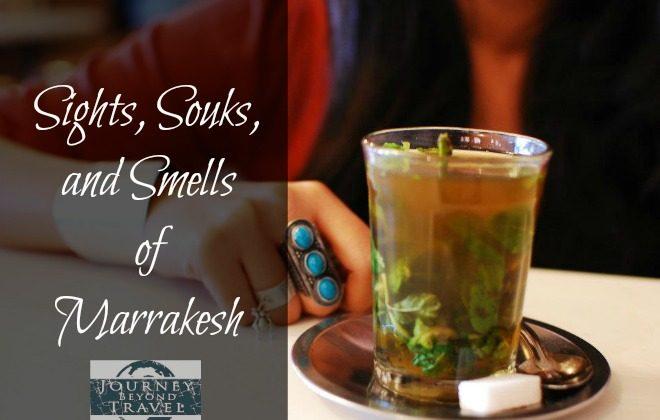Originally published at www.JourneyBeyondTravel.com
Morocco is a country unlike any other. And, Marrakesh is a city of equal stature. From getting lost in the maze of souks while trying to avoid the gravitational pull of each shop, we found ourselves in middle of the mayhem one February day.
We flew down to Marrakesh during the month of February. Since it isn’t a peak tourist season, everything was at a bustle, but it’s still more relaxed than other periods. We spent our first day simply walking around the souks at our own leisurely place.

It’s easy to get lost in the labyrinthine souks, but that’s the fun of it. A surprise lurks at every corner. An unassuming alley leads visitors to the Pottery Souk. Here, stores bedecked with brightly-coloured utensils are home to shopkeepers who leave no stone unturned to endear themselves to passersby. We might have ended with tagines that we didn’t need in the first place. Oh well! We also stumbled on the occasional tannery in this souk-maze. Moroccan leather is known the world over for its fine quality. It’s easy to spot putrid-smelling tanneries with freshly-dyed leather baking on the pavement here. The business of leather might be controversial, but it is ubiquitous in Marrakesh.
Then, of course, there are endless shops adorned with colourful Moroccan rugs, leather sandals, and miscellaneous souvenirs. We spent hours inspecting embroidered scarves and leather bags, interacting with artisans, bargaining, and bartering – before finally succumbing to the charms of persuasive vendors.
Ready for Lunch
When we got hungry, we hopped over to one of the dozens of restaurants lining the Djema- El-Fna. Moroccan food is flavourful, spicy, and provides a flavor that matches their rich culture. Plump couscous, round loaves of bread, tangy harira soup, well-marinated kebabs, and meats cooked in tagines. Who wouldn’t be tempted?!

The food might be delicious but it is the experience of sitting on a table facing the Djemaa-El-Fnaa that provides the proverbial icing on the cake. There are a number of restaurants in the vicinity, which have dozens of tables facing the main square. A menu is handed over to customers almost as soon as they take a seat. Moments later, a a small loaf of bread is slapped onto the table. It serves as a generic accompaniment for Moroccan tagines and stews. Try imitating the locals by tearing off a bit of the bread and scooping from the tagine with a bit of the sauce before launching it into your mouth. The texture of the bread compliments zesty Moroccan flavours perfectly.
An elaborate ritual – mint tea – follows nearly every meal. We spent countless hours pouring and drinking cups of frothy mint tea while munching on sweet dates.
Soaking Up the History
The historical monuments of Marrakech took us by surprise. The famed Bahia Palace is a feat of traditional architecture. Arab and Islamic architectural styles mingle in this intricate marvel from the nineteenth century. It is easy to spend hours marveling at the Palace’s carved ceiling, brightly-coloured tiles, and stained glass lamps. The peaceful courtyard of the Palace is close to the chaotic souks; it seems a million miles away.
The Bahia Palace is a prominent, highly visited feature in Marrakesh. But, it’s the the ruins of the El Badi Palace that are often ignored. There are never more than a handful of tourists in the compound – although storks abound. We were told that El Badi translates to “The Incomparable One.” In the sixteenth centure, the Saadian king, Al-Mansur, built it using precious materials such as gold and marble. But, it was subsequently looted and torn down by his successors. Today what remains of the El Badi Palace are bare ruins with a few mosaics. The ruins provide the perfect excuse to spend a languorous afternoon in the middle of Marrakesh.
After we were done admiring the panoramas of the majestic Atlas Mountains from the terrace of El Badi Palace, we took a horse-drawn carriage to the Menara Gardens. These expansive gardens are located towards the west of the city. There is an artificial lake, surrounded by fruit and olive trees, in the middle of the garden. This was the perfect way to escape the crowds of the Medina. Here pin-drop silence is the order of the day and you can hear birds chirping in the background.
As we sat, pondering over our trip to Marrakesh, we realized the city was so much more than we had expected. It certainly lived up to everything we had read about!
But, it was the hodgepodge of colour, chaos, good food, history, and culture that truly stands out.
And, there’s something else about Morocco that makes it special; an intangible quality that can’t be put into words. You need to visit Morocco to feel the gush of wind against your face at the foothills of the Atlas Mountains, the smell of a slow-cooked tagine, the reigning pandemonium in its local markets, coupled with the smiles on the faces of Moroccan people. Morocco has a certain ’smell of travel,' which can’t quite be articulated, only experienced.
Copyright © 2014 by Journey Beyond Travel. This article was written by Savi and Vid and originally published on journeybeyondtravel.com.


Friends Read Free